Related Research Articles
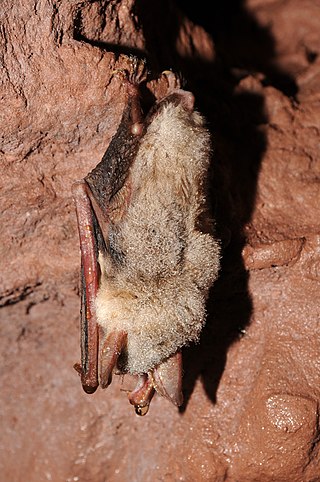
Vespertilionidae is a family of microbats, of the order Chiroptera, flying, insect-eating mammals variously described as the common, vesper, or simple nosed bats. The vespertilionid family is the most diverse and widely distributed of bat families, specialised in many forms to occupy a range of habitats and ecological circumstances, and it is frequently observed or the subject of research. The facial features of the species are often simple, as they mainly rely on vocally emitted echolocation. The tails of the species are enclosed by the lower flight membranes between the legs. Over 300 species are distributed all over the world, on every continent except Antarctica. It owes its name to the genus Vespertilio, which takes its name from a word for bat, vespertilio, derived from the Latin term vesper meaning 'evening'; they are termed "evening bats" and were once referred to as "evening birds".
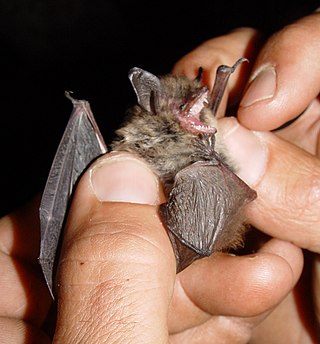
The mouse-eared bats or myotises are a diverse and widespread genus (Myotis) of bats within the family Vespertilionidae. The noun "myotis" itself is a Neo-Latin construction, from the Greek "muós and "oûs", literally translating to "mouse-eared".

Laurasiatheria is a superorder of placental mammals that groups together true insectivores (eulipotyphlans), bats (chiropterans), carnivorans, pangolins (pholidotes), even-toed ungulates (artiodactyls), odd-toed ungulates (perissodactyls), and all their extinct relatives. From systematics and phylogenetic perspectives, it is subdivided into order Eulipotyphla and clade Scrotifera. It is a sister group to Euarchontoglires with which it forms the magnorder Boreoeutheria. Laurasiatheria was discovered on the basis of the similar gene sequences shared by the mammals belonging to it; no anatomical features have yet been found that unite the group, although a few have been suggested such as a small coracoid process, a simplified hindgut, high intelligence, lack of grasping hands and allantoic vessels that are large to moderate in size. The Laurasiatheria clade is based on DNA sequence analyses and retrotransposon presence/absence data. The superorder originated on the northern supercontinent of Laurasia, after it split from Gondwana when Pangaea broke up. Its last common ancestor is supposed to have lived between ca. 76 to 90 million years ago.

The hoary bat is a species of bat in the vesper bat family, Vespertilionidae. It lives throughout most of North America.

Palaeochiropteryx is an extinct genus of bat from the Middle Eocene of Europe and North America. It contains three very similar species – Palaeochiropteryx tupaiodon and Palaeochiropteryx spiegeli, both from the famous Messel Pit of Germany, as well as Palaeochiropteryx sambuceus from the Sheep Pass Formation. They are usually found complete and exceptionally preserved, even retaining the outlines of their fur, ears, and wing membranes.
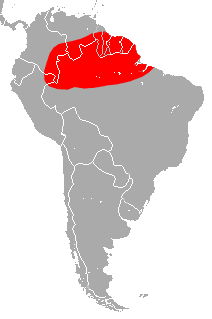
The lesser ghost bat is a bat species found in South America. It is one of six bat species worldwide to have white fur.

The velvety myotis, is a species of vesper bat from South America.

Platyrrhinus is a genus of leaf-nosed bats in the tribe Stenodermatini of family Phyllostomidae. Twenty-one species are known:

The Choco broad-nosed bat is a species of bat in the family Phyllostomidae. It is native to Colombia, Panama, and Ecuador, where it is found in the Choco region lowlands. It is threatened by habitat loss. In 2013, Bat Conservation International listed this species as one of the 35 species of its worldwide priority list of conservation.

Vampyressa is a genus of bats in the family Phyllostomidae, the leaf-nosed bats. They are known commonly as the yellow-eared bats or yellow-eared vampire bats.
MorphoBank is a web application for collaborative evolutionary research, specifically phylogenetic systematics or cladistics, on the phenotype. Historically, scientists conducting research on phylogenetic systematics have worked individually or in small groups employing traditional single-user software applications such as MacClade, Mesquite and Nexus Data Editor. As the hypotheses under study have grown more complex, large research teams have assembled to tackle the problem of discovering the Tree of Life for the estimated 4-100 million living species(Wilson 2003, pp. 77–80) and the many thousands more extinct species known from fossils. Because the phenotype is fundamentally visual, and as phenotype-based phylogenetic studies have continued to increase in size, it becomes important that observations be backed up by labeled images. Traditional desktop software applications currently in wide use do not provide robust support for team-based research or for image manipulation and storage. MorphoBank is a particularly important tool for the growing scientific field of phenomics.

Miniopterus, known as the bent-winged or long winged bats, is the sole genus of the family Miniopteridae. They are small flying insectivorous mammals, micro-bats of the order Chiroptera, with wings over twice the length of the body. The genus had been placed in its own subfamily among the vespertilionid bats, as Miniopterinae, but is now classified as its own family.

Bats are flying mammals of the order Chiroptera. With their forelimbs adapted as wings, they are the only mammals capable of true and sustained flight. Bats are more agile in flight than most birds, flying with their very long spread-out digits covered with a thin membrane or patagium. The smallest bat, and arguably the smallest extant mammal, is Kitti's hog-nosed bat, which is 29–34 mm (1.1–1.3 in) in length, 150 mm (5.9 in) across the wings and 2–2.6 g (0.071–0.092 oz) in mass. The largest bats are the flying foxes, with the giant golden-crowned flying fox reaching a weight of 1.6 kg (3.5 lb) and having a wingspan of 1.7 m.

The Cuban greater funnel-eared bat is a species of funnel-eared bat. It is endemic to a cave in westernmost Cuba.
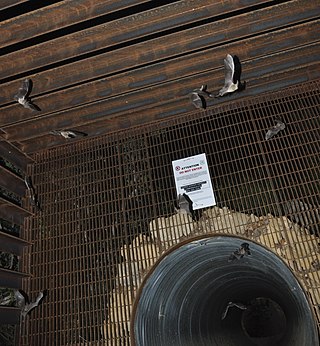
A maternity colony refers to a temporary association of reproductive female bats for giving birth to, nursing, and weaning their pups. The colonies are initiated by pregnant bats. After giving birth, the colony consists of the lactating females and their offspring. After weaning, juveniles will leave the maternity colony, and the colony itself will break apart. The size of a maternity colony is highly variable by species, with some species forming colonies consisting of ten or fewer individuals, while the largest maternity colony in the world in Bracken Cave is estimated to have over 15 million bats.
Patricia's disk-winged bat is a species of disk-winged bat found in South America.
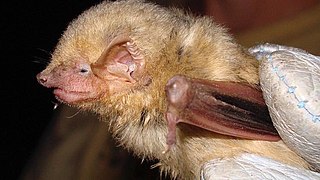
Dasypterus is a subgenus of Lasiurus. Collectively, members of Lasiurus (Dasypterus) are referred to as the yellow bats.
The Nimba myotis, also known as the orange-furred bat or Nimba Mountain bat, is a species of bat in the family Vespertilionidae. The species is endemic to the Nimba Mountains in Guinea, West Africa. It was discovered in 2018 and officially described in 2021 by a team of scientists from the American Museum of Natural History in partnership with a team from The University of Cameroon, which was led by American mammalogist Nancy Simmons.
References
- 1 2 3 4 5 6 7 8 "Nancy B. Simmons". American Museum of Natural History.
- 1 2 3 4 5 "Nancy B. Simmons Research Group". American Museum of Natural History.
- ↑ Nancy B. Simmons. "A New Species of Micronycteris (Chiroptera: Phyllostomidae) from Northeastern Brazil, with Comments on Phylogenetic Relationships" (PDF). American Museum of Natural History. Archived from the original (PDF) on 2018-08-25.
- ↑ Simmons, Nancy B.; Flanders, J.; Bakwo Fils, E. M.; Parker, Guy; Suter, Jamison D.; Bamba, Seinan; Keita, Mamady Kobele; Morales, Ariadna E.; Frick, Winifred F. (2021-01-13). "A new dichromatic species of Myotis (Chiroptera: Vespertilionidae) from the Nimba Mountains, Guinea (American Museum novitates, no. 3963)". American Museum Novitates. doi:10.1206/3963.1. hdl:2246/7249. ISSN 0003-0082. S2CID 231597274.
- ↑ "ATOL: Collaborative Research: Resolving Mammalian Phylogeny with Genomic and Morphological Approaches".
- ↑ ""Morpholution": An Authentic Youth Science Program".
- ↑ "Past Award Winners". Archived from the original on 2019-03-17. Retrieved 2019-03-04.
- ↑ "Outstanding Graduate Student Instructor Award | GSI Teaching & Resource Center". gsi.berkeley.edu. Retrieved 2019-03-04.
- ↑ "North American Society for Bat Research - Miller Award". www.nasbr.org. Retrieved 2019-03-04.